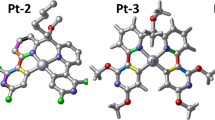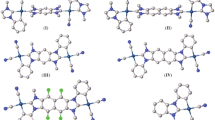Abstract
This paper presents a theoretical investigation of structural, optical, and phosphorescence properties of four cyclometalated Pt(II) complexes containing substituted 2-(2-thienyl)pyridine ligands using DFT and TD-DFT methods. Geometrical parameters of ground states were calculated and compared with available experimental data. Electronic absorptions were studied and assigned in terms of natural transition orbitals. Phosphorescence spectra have been simulated with adiabatic Hessian and adiabatic shift approaches according to the Franck–Condon approximation. Theoretical and experimental results agree and show that the four complexes exhibit two intense bands in orange region. Main normal modes involved in phosphorescence bands were analyzed and assigned.
Graphical abstract








Similar content being viewed by others
References
Barbosa, H. F. G., Attjioui, M., Ferreira, A. P. G., Moerschbacher, B. M., & Cavalheiro, É. T. G. (2020). New series of metal complexes by amphiphilic biopolymeric Schiff bases from modified chitosans: Preparation, characterization and effect of molecular weight on its biological applications. International Journal of Biological Macromolecules, 145, 417–428. https://doi.org/10.1016/j.ijbiomac.2019.12.153
Casado-Sánchez, A., Uygur, M., González-Muñoz, D., Aguilar-Galindo, F., Nova-Fernández, J. L., Arranz-Plaza, J., Díaz-Tendero, S., Cabrera, S., Mancheño, O. G., & Alemán, J. (2019). 8-Mercaptoquinoline as a ligand for enhancing the photocatalytic activity of Pt(II) coordination complexes: reactions and mechanistic insights. The Journal of Organic Chemistry, 84(10), 6437–6447. https://doi.org/10.1021/acs.joc.9b00520
Cheng, G., Kwak, Y., To, W.-P., Lam, T.-L., Tong, G. S. M., Sit, M.-K., Gong, S., Choi, B., Choi, W. I., Yang, C., & Che, C.-M. (2019). High-Efficiency Solution-Processed Organic Light-Emitting Diodes with Tetradentate Platinum(II) Emitters. ACS Applied Materials & Interfaces, 11(48), 45161–45170. https://doi.org/10.1021/acsami.9b11715
Dragonetti, C., Fagnani, F., Marinotto, D., di Biase, A., Roberto, D., Cocchi, M., Fantacci, S., & Colombo, A. (2020). First member of an appealing class of cyclometalated 1,3-di-(2-pyridyl)benzene platinum(ii) complexes for solution-processable OLEDs. Journal of Materials Chemistry C, 8(23), 7873–7881. https://doi.org/10.1039/d0tc01565b
El-Sayed, M. Y., Fetooh, H., Refat, M. S., Eldaroti, H. H., Adam, A. M. A., & Saad, H. A. (2019). Complexes of the plant hormone gibberellic acid with the Pt(II), Au(III), Ru(III), V(III), and Se(IV) ions: Preparation, characterization, and in vitro evaluation of biological activity. Journal of Molecular Liquids, 296, 111895. https://doi.org/10.1016/j.molliq.2019.111895
Sobottka, S., Nößler, M., Ostericher, A. L., Hermann, G., Subat, N. Z., Beerhues, J., Behr van der Meer, M., Suntrup, L., Albold, U., Hohloch, S., Tremblay, J. C., & Sarkar, B. (2020). Tuning Pt(II)-based donor-acceptor systems through ligand design: Effects on frontier orbitals, redox potentials, UV/Vis/NIR absorptions, electrochromism, and photocatalysis. Chemistry (Weinheim an der Bergstrasse, Germany), 26(6), 1314–1327.
Wang, S. F., Yuan, Y., Wei, Y. C., Chan, W. H., Fu, L. W., Su, B. K., Chen, I. Y., Chou, K. J., Chen, P. T., Hsu, H. F., Ko, C. L., Hung, W. Y., Lee, C. S., Chou, P. T., & Chi, Y. (2020). Highly efficient near-infrared electroluminescence up to 800 nm using platinum(II) phosphors. Advanced Functional Materials, 30(30), 2002173. https://doi.org/10.1002/adfm.202002173
Zhang, Z., Tizzard, G. J., Williams, J. A. G., & Goldup, S. M. (2020). Rotaxane Pt(II)-complexes: mechanical bonding for chemically robust luminophores and stimuli responsive behaviour. Chemical Science, 11(7), 1839–1847.
Zhang, Z., Zhao, Z., Wu, L., Lu, S., Ling, S., Li, G., Xu, L., Ma, L., Hou, Y., Wang, X., Li, X., He, G., Wang, K., Zou, B., & Zhang, M. (2020). Emissive platinum(II) cages with reverse fluorescence resonance energy transfer for multiple sensing. The Journal of the American Chemical Society, 142(5), 2592–2600.
Brahim, H., Haddad, B., Boukabene, M., Brahim, S., & Ariche, B. (2017). Theoretical study of geometric structures and electronic absorption spectra of Iridium(III) complexes based on 2-phenyl-5-nitropyridyl with different ancillary ligands. Computational and Theoretical Chemistry, 1101, 8–19. https://doi.org/10.1016/j.comptc.2016.12.016
Wang, L., Wen, J., He, H., & Zhang, J. (2014). The reasons for ligand-dependent quantum yields and spectroscopic properties of platinum(ii) complexes based on tetradentate O^N^C^N ligands: A DFT and TD-DFT study. Dalton Transactions, 43(7), 2849–2858. https://doi.org/10.1039/c3dt52616j
Brahim, H. (2019). DFT/TD-DFT investigation on the UV–vis absorption and phosphorescence spectra of platinum(II) and palladium(II) complexes with Schiff-base ligands. Journal of Luminescence, 210, 96–103. https://doi.org/10.1016/j.jlumin.2019.02.030
Guelai, A., Brahim, H., Guendouzi, A., Boumediene, M., & Brahim, S. (2018). Structure, electronic properties, and NBO and TD-DFT analyses of nickel(II), zinc(II), and palladium(II) complexes based on Schiff-base ligands. Journal of Molecular Modeling. https://doi.org/10.1007/s00894-018-3839-9
Schira, R., & Latouche, C. (2021). DFT vs TDDFT vs TDA to simulate phosphorescence spectra of Pt- and Ir-based complexes. Dalton Transactions, 50(2), 746–753. https://doi.org/10.1039/d0dt03614e
Seghir, I., Nebbache, N., & Brahim, H. (2021). Geometric, optical, and phosphorescent properties of cationic Ir(III) and Rh(III) complexes with cyclometalated ligands: DFT/TDDFT investigations. Monatshefte für Chemie-Chemical Monthly, 152(3), 315–322. https://doi.org/10.1007/s00706-021-02750-6
Luo, Y., Xu, Y., Zhang, W., Li, W., Li, M., He, R., & Shen, W. (2016). Theoretical insights into the phosphorescence quantum yields of cyclometalated (C∧C*) platinum(II) NHC complexes: π-conjugation controls the radiative and nonradiative decay processes. The Journal of Physical Chemistry C, 120(6), 3462–3471. https://doi.org/10.1021/acs.jpcc.5b12214
Stipurin, S., & Strassner, T. (2021). C^C* platinum(II) complexes with electron-withdrawing groups and beneficial auxiliary ligands: Efficient blue phosphorescent emission. Inorganic Chemistry, 60(15), 11200–11205. https://doi.org/10.1021/acs.inorgchem.1c01172
Yang, B., Ni, H., Wang, H., Hu, Y., Luo, K., & Yu, W. (2020). Enhanced synchronously emission dissymmetry factor and quantum efficiency of circularly polarized phosphorescence from point-chiral cyclometalated platinum(II) liquid crystal. The Journal of Physical Chemistry C, 124(43), 23879–23887. https://doi.org/10.1021/acs.jpcc.0c08106
Hadji, D., & Brahim, H. (2018). Structural, optical and nonlinear optical properties and TD-DFT analysis of heteroleptic bis-cyclometalated iridium(III) complex containing 2-phenylpyridine and picolinate ligands. Theoretical Chemistry Accounts. https://doi.org/10.1007/s00214-018-2396-8
Matsudaira, K., Mimura, Y., Hotei, J., Yagi, S., Yamashita, K. I., Fujiki, M., & Imai, Y. (2021). Magnetic circularly polarized luminescence from Pt II OEP and F 2 -ppyPt II (acac) under north-up and south-up Faraday geometries. Chemistry, 16(8), 926–930. https://doi.org/10.1002/asia.202100172
Xing, Y., Wang, L., Liu, C., & Jin, X. (2020). Effects of fluorine and phenyl substituents on oxygen sensitivity and photostability of cyclometalated platinum(II) complexes. Sensors and Actuators B: Chemical, 304, 127378. https://doi.org/10.1016/j.snb.2019.127378
Chen, W. C., Sukpattanacharoen, C., Chan, W. H., Huang, C. C., Hsu, H. F., Shen, D., Hung, W. Y., Kungwan, N., Escudero, D., Lee, C. S., & Chi, Y. (2020). Modulation of solid-state aggregation of square-planar Pt(II) based emitters: enabling highly efficient deep-red/near infrared electroluminescence. Advanced Functional Materials, 30(25), 2002494. https://doi.org/10.1002/adfm.202002494
Moon, Y. K., Huh, J.-S., Kim, S., Kim, S., Yi, S. Y., Kim, J.-J., & You, Y. (2020). Synthetic strategy for preserving sky-blue electrophosphorescence in square-planar Pt(II) complexes. ACS Applied Electronic Materials, 2(2), 604–617. https://doi.org/10.1021/acsaelm.9b00827
Zhang, H., Luo, Y., Yan, X., Cai, W., Zhao, A., Meng, Q., & Shen, W. (2020). Highly efficient blue-emitting of bis-cyclometalated tetravalent platinum (IV) complexes: A theoretical study. Inorganica Chimica Acta, 501, 119269. https://doi.org/10.1016/j.ica.2019.119269
Usuki, T., Uchida, H., Omoto, K., Yamanoi, Y., Yamada, A., Iwamura, M., Nozaki, K., & Nishihara, H. (2019). Enhancement of the photofunction of phosphorescent Pt(II) cyclometalated complexes driven by substituents: solid-state luminescence and circularly polarized luminescence. The Journal of Organic Chemistry, 84(17), 10749–10756. https://doi.org/10.1021/acs.joc.9b01285
Becke, A. D. (1993). Density-functional thermochemistry. III. The role of exact exchange. The Journal of Chemical Physics, 98(7), 5648. https://doi.org/10.1063/1.464913
Boukabene, M., Brahim, H., Hadji, D., & Guendouzi, A. (2020). Theoretical study of geometric, optical, nonlinear optical, UV–Vis spectra and phosphorescence properties of iridium(III) complexes based on 5-nitro-2-(2′,4′-difluorophenyl)pyridyl. Theoretical Chemistry Accounts. https://doi.org/10.1007/s00214-020-2560-9
Perdew, J. P. (1986). Density-functional approximation for the correlation energy of the inhomogeneous electron gas. Physical Review B, 33(12), 8822–8824. https://doi.org/10.1103/physrevb.33.8822
Perdew, J. P., Burke, K., & Wang, Y. (1996). Generalized gradient approximation for the exchange-correlation hole of a many-electron system. Physical Review B, 54(23), 16533–16539. https://doi.org/10.1103/physrevb.54.16533
Hay, P. J., & Wadt, W. R. (1985). Ab initio effective core potentials for molecular calculations. Potentials for the transition metal atoms Sc to Hg. The Journal of Chemical Physics, 82(1), 270. https://doi.org/10.1063/1.448799
Hay, P. J., & Wadt, W. R. (1985). Ab initio effective core potentials for molecular calculations. Potentials for K to Au including the outermost core orbitals. The Journal of Chemical Physics, 82(1), 299. https://doi.org/10.1063/1.448975
Latouche, C., Palazzetti, F., Skouteris, D., & Barone, V. (2014). High-accuracy vibrational computations for transition-metal complexes including anharmonic corrections: Ferrocene ruthenocene, and osmocene as test cases. Journal of Chemical Theory Computation, 10(10), 4565–4573. https://doi.org/10.1021/ct5006246
Latouche, C., Skouteris, D., Palazzetti, F., & Barone, V. (2015). TD-DFT Benchmark on inorganic Pt(II) and Ir(III) complexes. Journal of Chemical Theory and Computation, 11(7), 3281–3289. https://doi.org/10.1021/acs.jctc.5b00257
Naoui, M., Brahim, H., & Guendouzi, A. (2020). Theoretical investigation on green emitting heteroleptic cyclometalated iridium(III) complexes with fluorinated 2-phenylpyridine ligands. Journal of Photochemistry and Photobiology A, 398, 112624. https://doi.org/10.1016/j.jphotochem.2020.112624
Cancès, E., Mennucci, B., & Tomasi, J. (1997). A new integral equation formalism for the polarizable continuum model: Theoretical background and applications to isotropic and anisotropic dielectrics. The Journal of Chemical Physics, 107(8), 3032. https://doi.org/10.1063/1.474659
Cossi, M., Barone, V., Mennucci, B., & Tomasi, J. (1998). Ab initio study of ionic solutions by a polarizable continuum dielectric model. Chemical Physics Letters, 286(3–4), 253–260. https://doi.org/10.1016/s0009-2614(98)00106-7
Allouche, A.-R. (2010). Gabedit-A graphical user interface for computational chemistry softwares. Journal of Computational Chemistry, 32(1), 174–182. https://doi.org/10.1002/jcc.21600
Licari, D., Baiardi, A., Biczysko, M., Egidi, F., Latouche, C., & Barone, V. (2014). Implementation of a graphical user interface for the virtual multifrequency spectrometer: The VMS-Draw tool. Journal of Computational Chemistry, 36(5), 321–334. https://doi.org/10.1002/jcc.23785
Frisch, M. J., Schlegel, H. B., Scuseria, G. E., Robb, M. A., Cheeseman, J. R., Scalmani, G., Barone, V., Mennucci, B., Petersson, G. A., Nakatsuji, H., Caricato, M., Li, X., Hratchian, H. P., Izmaylov, A. F., Bloino, J., Zheng, G., Sonnenberg, J. L., Hada, M., Ehara, M., … Fox, D. J. (2009). Gaussian 09. Gaussian Inc.
Acknowledgements
The authors thank the directorate general for scientific research and technological development (DGRSDT), the thematic research agency in science and technology (ATRST) for funding.
Funding
This work is part of Projets de Recherche Formation-Universitaire (PRFU, MESRS, Algeria) supported by the directorate general for scientific research and technological development (DGRSDT, www.dgrsdt.dz) and the thematic research agency in science and technology (ATRST, www.atrst.dz). PRFU code: B00L01UN200120190002.
Author information
Authors and Affiliations
Corresponding author
Ethics declarations
Conflict of interest
On behalf of all authors, the corresponding author states that there is no conflict of interest.
Supplementary Information
Below is the link to the electronic supplementary material.
Rights and permissions
About this article
Cite this article
Mezouar, H., Brahim, H. Theoretical investigation on orange-emitting cyclometalated platinum (II) complexes containing organosilyl/organocarbon-substituted 2-(2-thienyl)pyridine ligands. Photochem Photobiol Sci 21, 1041–1053 (2022). https://doi.org/10.1007/s43630-022-00192-5
Received:
Accepted:
Published:
Issue Date:
DOI: https://doi.org/10.1007/s43630-022-00192-5




